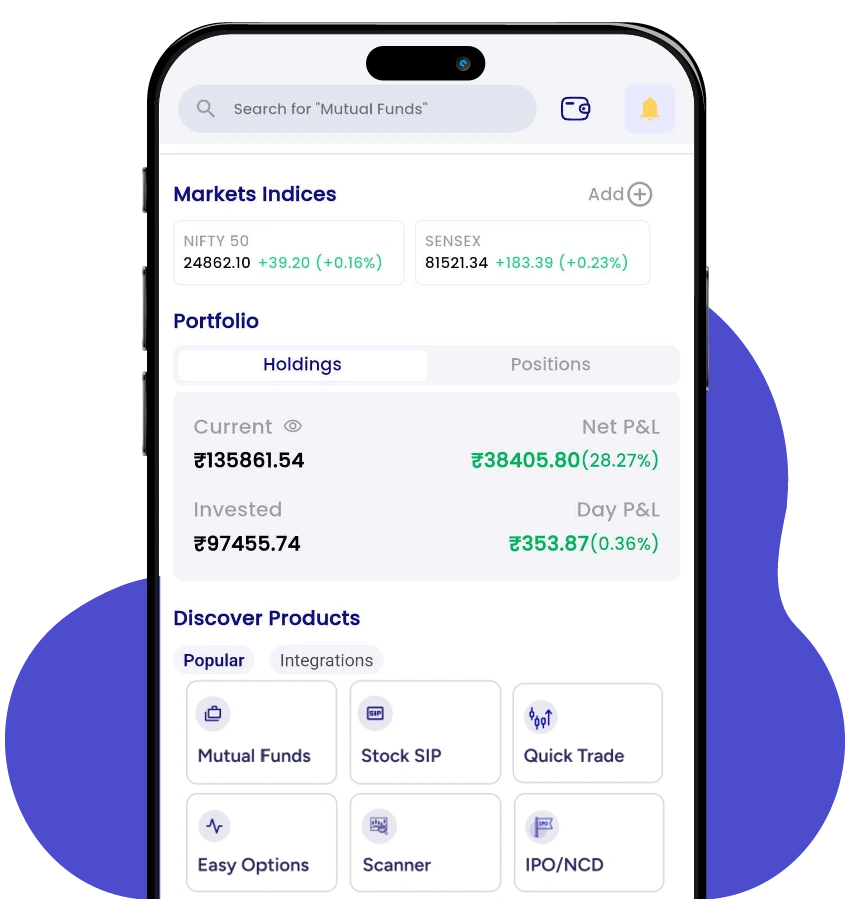How to Build a Good Portfolio?
- 27th June 2025
- 7 min read
Investing in the stock market is a key strategy for building long-term wealth. To achieve this, it is important to develop a strong and well-balanced portfolio, as it helps minimise investment risks. Additionally, maintaining a dynamic portfolio can provide financial flexibility to handle emergencies.
Read this blog to explore five effective tips to learn how to build a good portfolio for investments and common mistakes you must avoid to address risks.
What is a Portfolio in Investment?
An investment portfolio refers to a collection of financial assets owned by an investor, including stocks, bonds, currencies, and commodities. The primary goal of building such a portfolio is to generate profits while preserving the original capital.
Depending on their knowledge and experience in the investment market, individuals may choose to manage their portfolios independently or seek guidance from professional financial advisors. Financial experts emphasise diversification as a core strategy in portfolio management to minimise market risks.
5 Tips on How to Make a Good Investment Portfolio
An investment portfolio is built by aligning assets to meet financial goals. Follow these five tips to know how to build good portfolio for investment:
-
Identify Your Financial Goals
First of all, you need to identify your investment goals. You need to make sure what your purpose is for investing in securities. It can be retirement planning, saving funds for children’s education, or purchasing an asset. It may include both short-term and long-term investments, or you may take higher risks if you have more time on hand.
There can also be some medium-term goals, like going on your dream vacation or renovating your home. You may also take advice from your financial advisor about these.
-
Assess Your Risk Tolerance
Considering your risk tolerance is also crucial in building an investment portfolio. Ask yourself whether you are willing to earn higher returns by considering the risks of losing some money, or choose safer and risk-free assets which can provide no higher returns.
In addition, the amount of risk you can tolerate will determine how your investments will be allocated to different asset classes. Most investors do not know how much risk they can tolerate until they have invested for many years. It is recommended to take lower risks if you are a beginner in stock market investment.
-
Focus on Diversification
To build a good investment portfolio, it is crucial to diversify your investments. It allows you to spread all of your investment across different asset classes, which can reduce your risks.
There are several ways you can diversify your portfolio. You can choose a mix of large-, small- and mid-cap stocks. You must also include bonds, stocks, mutual funds and other assets to avoid risks.
Consider investing in assets of diverse industries to reduce the involved risks. For instance, you can divide your allocated funds into commodities, technology, and the real estate industry to outperform even when stocks struggle.
-
Choose the Right Securities
Select the securities by analysing the return potential, fundamentals, and liquidity. You need to shortlist the securities that align only with your risk tolerance, budget, investment horizon, and other preferences. For instance, if you consider taking medium risks, then investing in mid-cap stocks or multi-asset funds can be beneficial for you.
Building a solid investment portfolio that can withstand market fluctuations requires careful securities selection. You can use fundamental analysis, which evaluates a company’s intrinsic worth based on its financial conditions and growth prospects.
-
Ensure Portfolio Rebalancing and Monitoring
Try to rebalance your portfolio after establishing it, since it allows you to buy low and sell high. Over time, it also increases possible returns. Encouraging a systematic approach to investing reduces emotional reactions to market swings.
Portfolios should be reviewed and rebalanced regularly to ensure alignment with changing market conditions and financial objectives.
It is crucial to keep in mind that if you wait too long between adjustments, major market shifts might disrupt your plan and increase your investment risk. Additionally, you can lose out on chances to purchase at cheap prices or sell at high prices if you do not rebalance frequently.
Common Mistakes to Avoid While Building a Good Portfolio
As you know how to create a good investment portfolio, it is also crucial to avoid common mistakes that can pose risks to your investment portfolio. Here are a few you must avoid:
-
Under- and Over-Diversification
One of the worst investment mistakes to avoid is putting all of your money into one asset class, as your exposure to market swings is increased with this. By distributing investments too widely over several assets, over-diversification can reduce possible returns and make it more difficult to realise sizable profits.
-
Emotional Attachment to Securities
Emotionally investing in an asset can lead to an aversion to diversification and stop loss. This can be caused by past achievements or strong faith in its future, despite conflicting fundamental signals.
-
Lack of Research
Using advice from friends or social trends, inexperienced investors often invest in assets they do not fully understand. One of the most frequent mistakes made by novice investors is neglecting research, which can lead to large losses.
-
Timing the Market
Many people try to predict when the market will peak or fall. However, there are countless miscalculations. Consistently predicting market changes is difficult for even seasoned investors, and trying to do so can lead to lost opportunities and higher transaction costs.
-
Lack of Monitoring
Lack of monitoring of your portfolio and the market can lead to problems. You can overlook important indicators that your portfolio needs to be rebalanced or that underperforming assets need to be addressed.
Final Thoughts
The tips above help you to know how to build a good portfolio. You must identify investment goals, diversify your investment, choose the right securities and rebalance your portfolio to have a good portfolio. However, you must also avoid some common mistakes to improve the performance of your portfolio.
Are you a beginner and want to start your investment journey? Download the PL Capital Group – Prabhudas Lilladher application and open a Demat account for free! PL Capital also professionally manages investment services in association with experienced investment experts.
Frequently Asked Questions
1. Why is it crucial to diversify your portfolio?
Portfolio diversification is crucial since it spreads all of your investment across different asset classes, which reduces your risks.
2. How can I determine my risk tolerance?
You can determine your risk tolerance by considering whether you are willing to risk higher returns on risky assets or opt for risk-free options that offer lower returns.
3. How to build a good investment portfolio?
Building a good investment portfolio requires maintaining some good practices. These include identifying financial goals, diversifying your investments, ensuring portfolio rebalancing, and avoiding emotional attachment.
4. How frequently should I rebalance my portfolio?
You should rebalance your portfolio, taking suggestions from your financial advisors. However, professionals advise rebalancing a portfolio every six to twelve months.





